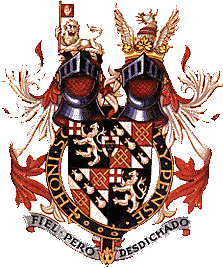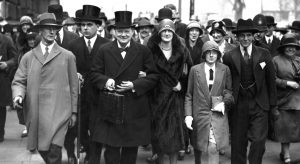
Reference
The Rounded Picture

Winston Churchill, Parliament Square, London © Sue Lowry & Magellan PR
January 17, 2009
By Martin Gilbert
Finest Hour 65
When Randolph Churchill began work on his father’s biography in 1961, he had at his disposal an estimated 15 tons of paper — his father’s personal archive, now at Churchill College, Cambridge. In 1962, when I joined his research team, Randolph had already begun to search out yet more material.
How vividly I remember his delight when one or other researcher (and especially the director of research, Michael Wolff) brought to the seclusion of Randolph’s house in the Suffolk village of East Bergholt, where we worked, yet another batch of the hundreds of letters written by Winston Churchill to friends and colleagues, of which Winston himself had kept no copy.
One such batch of letters, misfiled in the New York public library under the American novelist Winston Churchill, contained a dozen remarkable descriptions by Churchill of his early political efforts and ambitions, while still (until 1904) a young Conservative, hesitating whether or not to join the Liberal Party. Another batch of such handwritten letters was kept at her home in a locked box by Pamela, Countess of Lytton, of whom Churchill had once written (to his mother) that she was “the most beautiful girl I have ever seen”.

2024 International Churchill Conference
These letters to Lady Lytton spanned the years 1898 to 1959. “I am getting much older now the stimulus of power and responsibility has fallen from me,” he wrote to her in June 1955, “and I totter along in the shades of retirement.”
As well as Churchill’s letters to his friends, there were also other letters of his which, on a vast scale, had begun to transform Randolph’s work by 1968, and which subsequently transformed mine. These were the long, affectionate, and almost always handwritten letters which Churchill sent to his wife whenever they were apart, a fine collection of which, The Chartwell Bulletins 1935, has recently been published by the Churchill Society. The day on which Lady Churchill decided that these letters could become a part of the biography ensured a truly remarkable extra dimension of our knowledge of Churchill’s moods and motives.
One letter in particular has remained engraved on my mind since the day I first read it, now nearly a quarter of a century ago. Dated 28 March 1916, it was written from the trenches on the Western Front. Churchill had just watched a German artillery barrage traverse the front line. One shell exploded quite near him. Had he been hit, he wrote to his wife that night, it would have been “a good ending to a chequered life, a final gift — unvalued — to an ungrateful country, an impoverishment of the war-making power of Britain which no one would ever know or mourn.”
Every one of Churchill’s letters to his wife are included in the published document volumes (known as Companion Volumes) of which 13 have been published, with a further 10 in prospect. [Ed. The War Papers, Volumes 1 and 2 have now been published – 1999] These document volumes, initially imposed by Randolph on a somewhat reluctant publisher, make available to the reading public the full range of Churchill’s private correspondence; and will form the basis of innumerable future studies — and indeed of future biographies.
On being confronted by such a formidable amount of personal material, Randolph Churchill adopted as the motto for the biography: “He shall be his own biographer.” Churchill’s letters were to be the basis of his son’s narrative. One must remember that in 1962, no Cabinet, or even departmental, documents could be used. In view of the 50-year rule which was then in force, the most recent official archives available were those for the year 1912.
In 1965 (the year of Churchill’s death, and three years before Randolph’s) the law regarding government documents changed. Instead of having to wait until 50 years had passed before secret documents could be seen, a 30-year rule was established. To this day I am unable to forget that had the 50-year rule remained in force, the official archives would even now be open only up to 1940. The inner workings of Churchill’s leadership in the Second World War would still be largely secret.
Since 1965 Churchill has no longer had to be “his own biographer”, even though his personality still towers over every page of the narrative. I am quite content that this should be so; indeed, it has been my aim to try to place the reader in Churchill’s presence.
In 1979, the Government agreed to open the archives of the Second World War in their entirety, including those of the Ministry of Defence, of which Churchill had made himself the head in May 1940. It now became possible to study papers such as the meetings of the War Cabinet, the Chiefs of Staff Committee — over which Churchill presided — and the Defence Committee, which took some of the most sensitive decisions in 1940, including the decision not to open peace negotiations after the fall of France. For Churchill’s biographer, the unforeseen opening of the official archives made possible a quite different, intricate and comprehensive narrative. It also demanded, if justice were to be done to Churchill’s achievements, two volumes more than had been envisaged in the original scheme.
It now became possible to go far beyond even Churchill’s own six-volume account of his war leadership; to see the actual arguments which were put forward at the time for and against every element of war policy, to see where Churchill prevailed and where he was overruled, and above all to trace the impact of Enigma — the British eavesdropping on the most secret messages passing between German headquarters and the senior commanders on land, sea and air.
By a coincidence of timing, the two volumes of the Churchill biography covering the Second World War became the first books about a war leader which were able to show the part which this most secret source had played at the highest level of decision making.
Churchill called the Enigma messages his “golden eggs”. After the war he pressed for honours for those who had helped to decrypt them, noting in a Top Secret message in May 1945 that the advantages gained through Enigma “in the whole course and conduct of the war, cannot be overestimated”.
Also opened as a result of the 30-year rule were the full, unedited transcripts of every meeting and telegraphic exchange between Churchill and Roosevelt, and between Churchill and Stalin. Churchill’s opening remarks when he and Stalin met for the first time in 1942 were: “I would not have come to Moscow unless I felt sure that I would be able to discuss realities.” The first of those realities was the Anglo-American inability to mount a Second Front in 1942, or even in 1943. The British interpreter jotted down on his note pad how, on hearing this bad news, “Stalin’s face crumpled up into a frown.” Patiently, Churchill set about explaining to the Soviet leader the reasons for the delay.
By combining Churchill’s private papers with the government’s archives, every episode of Churchill’s stormy career can now be separated from the long and often bizarre accumulation of myth and half truth. It is possible to trace in detail, for example, Churchill’s determined attempts to give the miners’ grievances due weight during the Coal Strike in 1926, when he was Chancellor of the Exchequer, and his equal determination to end the Cold War in 1955 by urging President Eisenhower to accept a new concept, that of a summit, to be held with Stalin’s successors. “I have a strong belief that Soviet self-interest will be their guide,” Churchill explained to Eisenhower in May 1953, over 36 years ago, and he added: “My hope is that it is their self-interest which will bring about an easier state of affairs”.
Churchill’s second premiership, portrayed by his doctor, Lord Moran, as a time of dotage, can now be seen, thanks to the opening of the government archives, as a period when he was very much alert to the many issues pressing in upon his fellow countrymen, from housing to the hydrogen bomb. His desire for a summit on the nuclear issue, and the care and precision with which he argued his case, are hardly the marks of a senile Victorian.
Twenty-one years ago it was my good fortune to have been given by Merton College, of which I was then a junior research fellow, an extended sabbatical, so that no teaching, lecturing, examining or administrative duties, could come between me and the biography, the completion of which, at times, seemed very distant. Once, however, coming across a phrase by Churchill — “work, which is a joy” — I understood at once what he meant. I was lucky to have had an unbroken twenty-one years of such joy.
Subscribe
WANT MORE?
Get the Churchill Bulletin delivered to your inbox once a month.




